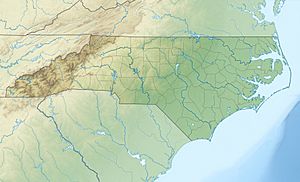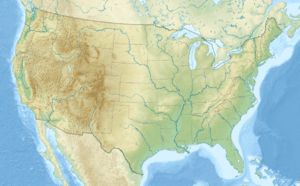Marsh Creek (Crabtree Creek tributary) facts for kids
Quick facts for kids Marsh Creek |
|
|---|---|
|
Location of Marsh Creek mouth
|
|
| Other name(s) | Tributary to Crabtree Creek |
| Country | United States |
| State | North Carolina |
| County | Wake |
| City | Raleigh |
| Physical characteristics | |
| Main source | divide between Marsh Creek and Perry Creek Raleigh, North Carolina in Northridge Country Club 408 ft (124 m) 35°52′19″N 078°37′03″W / 35.87194°N 78.61750°W |
| River mouth | Crabtree Creek east side of Raleigh, North Carolina 174 ft (53 m) 35°47′43″N 078°35′43″W / 35.79528°N 78.59528°W |
| Length | 6.21 mi (9.99 km) |
| Basin features | |
| Progression | southeast |
| River system | Neuse River |
| Basin size | 9.58 square miles (24.8 km2) |
| Tributaries |
|
| Bridges | Spring Forest Road, Volant Drive, Falls Church Road, Quail Ridge Road, Hodge Creek Drive, Old Wake Forest Road, Atlantic Avenue, East Millbrook Road, New Hope Church Road, Ingram Drive, US 1, Stoney Brook Drive, North Raleigh Boulevard, Timberlake Drive, I-440, Yonkers Road |
Marsh Creek is a stream in Wake County, North Carolina. It flows for about 6.21 mi (9.99 km) (about 10 kilometers). This creek is a "tributary," which means it's a smaller stream that flows into a larger one. Marsh Creek flows into Crabtree Creek. It's considered a "2nd order stream," meaning it's formed by two smaller streams joining together.
Where Marsh Creek Flows
Marsh Creek starts in the northeastern part of Raleigh, North Carolina. From there, it flows towards the southeast. It travels through the eastern areas of Raleigh. Finally, it joins Crabtree Creek near where the US 64 highway and I-440 interstate meet.
The land around Marsh Creek is mostly developed. This means there are many buildings, roads, and homes. Only a small part, about 6%, is covered by forests.
Marsh Creek's Water Area
The area that drains water into Marsh Creek is called its "watershed." This watershed covers about 9.58 square miles (24.8 km2) (about 24.8 square kilometers). All the rain that falls in this area eventually flows into Marsh Creek.
On average, the watershed gets about 46.6 inches (about 118 centimeters) of rain each year. This water helps keep the creek flowing.



